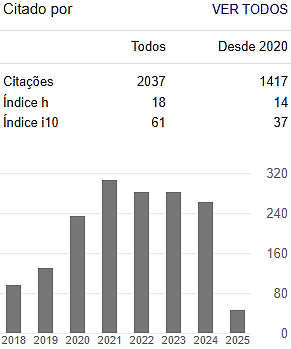NITROGEN USE EFFICIENCY IN TRANSGENIC TOBACCO PLANTS WITH HIGH ACCUMULATION OF PROLINE
Abstract
Increasing the nitrogen use efficiency (EUN) of crop plants is a result of the improvement in the mechanisms involved in nitrogen uptake, translocation, assimilation and remobilization. In this study, tobacco plants with high accumulation of proline caused by the insertion of the VaP5CSF129A mutant gene under control of the constitutive promoter CaMV 35S was used as a model to investigate the effect of overexpression of the transgene in the uptake and utilization of N. For this, an experiment was carried out in a completely randomized design, in a 2x5 factorial arrangement, with two genotypes (transgenic event and untransformed control) and five levels of nitrogen fertilization (25, 50, 100, 200 and 400 kg N ha-¹), cultivated under greenhouse conditions. Plants were evaluated for height, number of leaves, dry mass, free proline content, nitrogen content, total protein content and use of the applied N (efficiency of absorption - EAbs, efficiency of leaf utilization – Eutil and efficiency of plant use - EUN). The plants of the transgenic event with high proline accumulation were less efficient than the control plants in terms of nitrogen absorption (lower levels of N in root, leaves and whole plant), which resulted in lower EAbs. There was no difference between the transgenic and control genotypes for EUtil. However, the transgenic plants presented lower EUN in comparison to the control plants. Our data showed that transgenic tobacco plants with high proline accumulation do not have potential for direct use in agricultural systems, since the alteration of the biochemical balance between the metabolisms of nitrogen and carbon did not result in plants with higher EUN.
Downloads
Downloads
Published
Issue
Section
License
Copyright (c) 2019 Colloquium Agrariae. ISSN: 1809-8215

This work is licensed under a Creative Commons Attribution-NonCommercial-NoDerivatives 4.0 International License.

